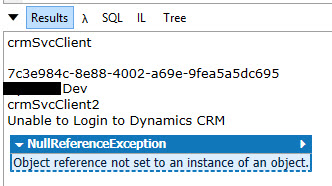Caching behavior of the last Dynamics SDK is driving me crazy.
First, if you want to use CrmServiceClient to access different environments you have to use the parameter RequireNewInstance=True; in the connection string. If not, every instance of CrmServiceClient will use the same connection, even if you create and dispose instances to different environments.
Now, even if you use the RequireNewInstance=True; in the connection string I found that cache still occurs in some scenarios.
var client1 = new CrmServiceClient("RequireNewInstance=True;
Url=https://myCompany.crm.dynamics.com;
[email protected]; Password=myPassowrd;
AuthType=Office365");
//Now, client 2 points to a url that doesn’t exists:
var client2 = new CrmServiceClient("RequireNewInstance=True;
Url=https://xxx.crm.dynamics.com; [email protected];
Password=myPassowrd; AuthType=Office365");
The client2 keeps using the first connection string, so you cannot determine if the new connection string is correct.
Any ideas how to test Dynamics Crm connections strings correctly in my asp.net application?

